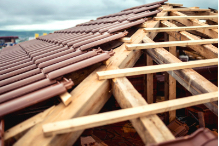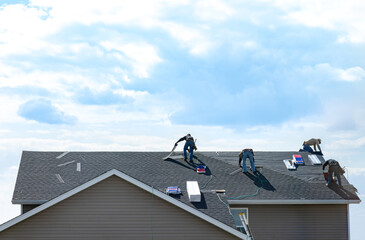 Roofing is a fundamental element of a building. It is the top covering of all materials and constructions that protect a building from weather. As part of the building’s envelope, the roof is a primary source of heat, light, and air conditioning. The types of roofing materials available today range from asphalt shingles to metal. Read on to learn more about these different types of roofs. Roofing materials can be used to cover various types of structures, from single-family homes to complex structures.
Roofing is a fundamental element of a building. It is the top covering of all materials and constructions that protect a building from weather. As part of the building’s envelope, the roof is a primary source of heat, light, and air conditioning. The types of roofing materials available today range from asphalt shingles to metal. Read on to learn more about these different types of roofs. Roofing materials can be used to cover various types of structures, from single-family homes to complex structures.
There are 14 common types of roofs used for residential and commercial buildings. Choosing the right Spring Valley Roofing for your home or building depends on its design and use. It would help if you considered several factors, such as its lifespan, cost, and ease of maintenance. In this article, we’ll explore all 14 types of roofs and how they can benefit your building. In addition, we’ll also discuss the benefits of each.
Gable
This type of roof has a triangular shape and can be built with almost any material and pitch. A mansard is a traditional style of roof that is reminiscent of the French house style. Similarly, a mansard roof is characterized by two steep slopes on either side, with the lower slope being steeper than the upper one. Mansard roofs are often used for home additions, porches, and garages.
Hip
Hip roofs are generally made with various roofing materials. Hip roofs are simple in design, with ridges on two sides and a polygon on the other. A cross hip roof is similar to a gable roof but features two sides that are perpendicular to each other. This type of roof can hold up well to rain and snow and has more design options than a simple hip roof.
Materials Used
The materials used for roofing have several distinct properties. These characteristics include thermal conductivity, insulation, and expansion rates, among others. Certain roofing materials are better suited to certain climates than others. Another important factor is the shape, texture, and strength of the roof. In general, asphalt shingles will provide between six and nine years of solid service. Steel, on the other hand, is prone to corrosion and is unsightly. However, it can last for a hundred years.
Traditional roof tiles are usually made of Terracotta, but in many cases, concrete has taken its place. Concrete is also a good choice because it is easy to work with. Steel can also be a viable alternative, and plastic tiles are increasingly popular with homeowners who want a unique look. Despite being relatively inexpensive, these tiles are often quite heavy. However, they are more durable than some other types of roofing materials. In addition, the cost of concrete tiles can be prohibitive for some homeowners.
Choosing the right material for your roofing project can be complicated, but you can find a wide range of options to meet your needs. Many of them are weatherproof and will protect your building from both natural and man-made elements. Before selecting a material for your roof, make sure to consider the shape, use, and location of the building. If you are planning to do a renovation, it is important to consider the style of the building so you can choose the right material for your project.
Pitched Roofs
A pitched roof is a type of roof structure with a sloping top surface. They are particularly useful in areas that experience heavy rainfall. Because of their low cost and ease of installation, these roof structures are often the most affordable way to cover a structure. Common uses of this type of roofing include godowns, sheds, theaters, and mountain cabins. This type of roof structure is generally designed for climatic conditions and can be made of many different types of materials, including wood and metal.
Another benefit of a pitched roof is that they tend to need less maintenance and have a lower initial cost. This can be particularly beneficial for those looking to build a new home. A pitched roof also reduces the risk of water damage since the steep slope helps guide rain and snow off the roof. Pitched roofs are also highly resistant to harsh weather conditions. The steep slopes of a pitched roof also make them ideal for solar panels.
The simplest type of pitched roof is the couple roof. The couple roof comprises two lengths of timber anchored together at the top. A pair of ceiling joists run between the rafter feet. These joists prevent the walls from deflecting outward and increase the potential roof span. Pitched roofs are also often used to support a flat ceiling. If you plan to build a couple of pitched roofs on a single structure, ensure that you check the zoning regulations before deciding on the roof type.
Metal Roofs
Many commercial properties have chosen metal roofing over asphalt shingles or other types of roofs because of its superior resistance to weather, especially in hotter climates. This durability gives building owners peace of mind knowing that they don’t have to constantly maintain their roofs. Listed below are some benefits of metal roofing. Below are some of the pros and cons of metal roofing. If you are considering installing a metal roof, you should first consider its cost.
Depending on the quality of metal used, metal roofs can be expensive. However, these initial costs will typically be offset by the energy savings you’ll see. Metal roofs also have the advantage of being quieter than other roof types. Another downside of metal roofs is that they are more likely to dent, so if you’re afraid of falling on your roof, make sure you know how to walk on it without injuring yourself.
While there are some downsides to metal roofing, many of the pros outweigh these disadvantages. Cool metal roofs reduce heating and cooling loads on buildings and are suited for both new and retrofit applications. Cool metal roofs have solar reflectance and infrared emittance properties that make them ideal for cooling and even mitigating the effects of the urban heat island. Some cool metal roofs can be as large as one million square feet. They can be insulated and still retain 95% of their original reflectance.
Clay tile
If you live in an area that gets a lot of frosts, clay tile roofing can be a great choice. This type of roofing is molded clay and comes in a variety of colors, including the classic Terracotta. However, the most important thing to know before installing this type of roof is whether it’s suitable for your climate. Before deciding to install clay tiles, you should conduct thorough research about their performance. Fortunately, there are many advantages to choosing this type of roofing over other types.
First of all, clay tiles last a long time. While most of these tiles have a great lifespan, regular maintenance is necessary to ensure the tile will look its best for many years. Performing a thorough internal and external inspection will help you identify any problems and develop a preservation plan. This will help you determine how to safely and economically repair damages that have been caused by the weather. Likewise, it will help you determine whether you need to install special roofing hardware, such as snow clips or snow birds.
In addition to its long life, clay roofing tiles require less maintenance than other types of roofing materials. Depending on the grade of tiles, you can expect your roof to last 50 to 100 years without needing any major repairs. Furthermore, the material is also fire and insect-resistant. In addition, clay tile roofing is highly fire and insect-resistant. Another benefit to clay tile roofing is that it doesn’t need to be cleaned regularly. You should also consider the type of clay roofing that you plan to install.
EPDM Membranes
Thermoplastic olefin (TPO) and EPDM membranes are both good choices for flat roofing. Both are durable and can last for over 20 years. TPO is more economical but also comes in white, which is ideal for many boroughs’ requirements. Both TPO and EPDM membranes are easy to repair and maintain. They can last for a decade or more, depending on the type of material you choose.
The process of preparing an EPDM membrane involves curing a sheet of ethylene-propylene-diene-monomer (EPDM) rubber that may contain additives. The EPDM sheet may be single or multi-ply and may not be reinforced with fabric. In many cases, however, the sheet can be cured during any of the following steps. This process is generally faster than that of other roofing membranes.
Depending on the type of roofing application, EPDM and TPO membranes can be unrolled over a roof substructure in a conventional fashion. The width of the seams may vary depending on the design requirements of the architect or building contractor. A conventional adhesive may be used to join seams, such as Firestone Building Products Company’s SA-1065. Membrane systems may be applied using a brush, spray, or other known application methods.
During this process, non-black EPDM samples were prepared and evaluated for their self-extinguishing and burn resistivity. Non-black EPDM samples were prepared similarly and subjected to testing of their physical and fire resistance. A mixture of EPDM and talc, stearic acid, and zinc oxide was added to test specimens. The EPDM and plasticizers were then exposed to flames from a propane torch. The results of the tests indicated that non-black EPDM was more likely to exhibit a low fire resistance than black EPDM.


